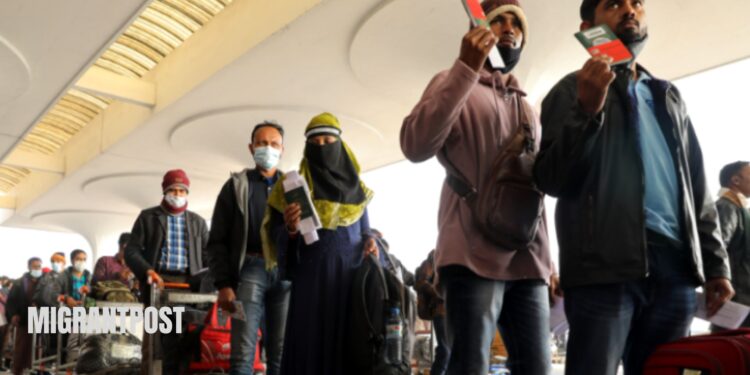Peer Tanim Ahmad, MP Report, Dhaka – As the world grapples with shifting labor dynamics and evolving demand for skilled and unskilled workers, Bangladesh’s workforce is at the center of attention. In order to capitalize on these opportunities, Bangladesh needs to focus on improving the quality of its education and training system. The country also needs to make it easier for businesses to recruit and deploy workers overseas. There are a number of factors that have contributed to the growth of manpower export from Bangladesh. One factor is the increasing demand for labor in developed countries. Due to aging populations and declining birth rates, many developed countries are facing a shortage of workers. This has created opportunities for Bangladeshi workers to find employment in these countries. The growth of manpower export from Bangladesh has had a number of positive benefits for the country. It has helped to reduce unemployment and poverty in Bangladesh. It has also helped to increase the country’s foreign exchange reserves. This has allowed the government of Bangladesh to invest in infrastructure and other development projects. However, the industry is facing a number of headwinds, including the global economic slowdown, the rising cost of living in destination countries, and the increasing competition from other countries.
Opportunities abound
With a population exceeding 160 million, Bangladesh boasts a large and youthful workforce. This demographic advantage presents an enormous opportunity for the country to expand its presence in international labor markets. There are opportunities for Bangladesh to grow its manpower exports as the country has a young and growing population with a high literacy rate, which makes it an attractive source of labor. Bangladesh is also a lower-cost destination than many other countries, which gives it a competitive edge.
Bangladesh has traditionally been known for sending workers to the Middle East, primarily in the construction and domestic service sectors. However, recent trends indicate a diversification of destinations and job categories. While Middle Eastern countries remain significant destinations, Bangladesh is increasingly eyeing emerging markets in Asia, including Malaysia, Singapore, South Korea, and Japan. These countries are seeking workers to address labor shortages in various industries, from manufacturing to healthcare. The government of Bangladesh has been actively promoting skill development programs to equip its workforce with the necessary expertise for overseas employment. Skilled workers, including technicians, engineers, and healthcare professionals, are in high demand globally, offering a new avenue for export. The rise of the digital economy has created opportunities for remote work. Bangladesh’s young population, coupled with improving internet connectivity, positions the country to tap into the growing demand for remote workers in fields such as IT, digital marketing, and content creation.

Challenges on the horizon
Despite these promising opportunities, Bangladesh’s manpower exports face several challenges that must be addressed for sustained growth and success. Ensuring that workers’ rights are protected and that they receive fair wages is a top priority. Bangladesh needs to strengthen its regulatory framework to safeguard its workers abroad, mitigate the risk of exploitation, and maintain its reputation as a responsible labor exporter. While progress has been made in upskilling the workforce, there is still a considerable skills gap that needs to be bridged to meet the specific demands of foreign employers. Continuous investment in vocational training and education is essential. Global geopolitical shifts can impact labor markets. Bangladesh must stay attuned to changing international relations and policies that may affect its labor exports to certain countries. The COVID-19 pandemic exposed vulnerabilities in the overseas employment sector. Developing a robust contingency plan for future crises is crucial to safeguarding the interests of Bangladeshi workers abroad. The government has taken some steps to address these challenges. For example, the Ministry of Expatriates’ Welfare and Overseas Employment has launched a number of initiatives to improve the skills of Bangladeshi workers and make it easier for them to find jobs overseas.
However, to address these challenges and capitalize on opportunities, the Bangladeshi government, in collaboration with private sector stakeholders, needs to actively pursue a comprehensive strategy.
Regulatory frameworks need to be strengthened to ensure the welfare and rights of overseas workers. Vocational training programs have to be expanding to equip workers with the skills demanded in global job markets. And new partnerships with foreign governments and businesses to continue to explore new opportunities to facilitate more overseas employment. Technology needs to be embraced to streamline the recruitment and deployment processes and promote ethical recruitment practices and discourage illegal brokers.
Overall, manpower export is a growing opportunity for Bangladesh. The country has a large and growing surplus of labor, and the demand for labor in developed countries is increasing. The government of Bangladesh is working to address the challenges associated with manpower export so that Bangladeshi workers can continue to benefit from this opportunity. Another factor that has contributed to the growth of manpower export from Bangladesh is the improvement in the skills and qualifications of Bangladeshi workers. The government of Bangladesh has been investing heavily in education and training programs to improve the skills of its workforce. This has made Bangladeshi workers more attractive to potential employers in developed countries.
















Maisy Wang